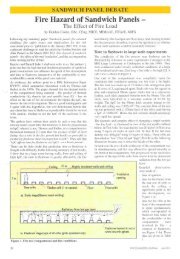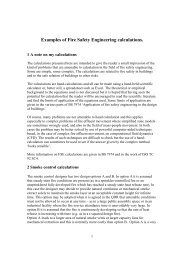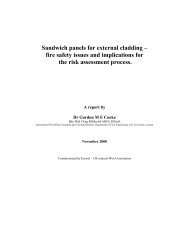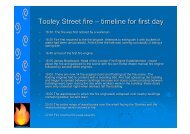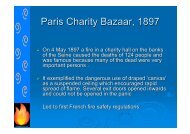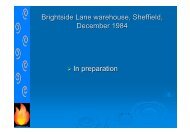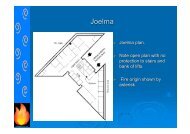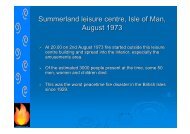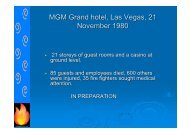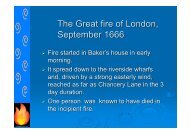Examples of Fire Safety Engineering calculations. - Cooke On Fire
Examples of Fire Safety Engineering calculations. - Cooke On Fire
Examples of Fire Safety Engineering calculations. - Cooke On Fire
Create successful ePaper yourself
Turn your PDF publications into a flip-book with our unique Google optimized e-Paper software.
From Equation (3)P = 14 x 10 -6 x 150 2 x 0.3 x 200,000 x 680 = 12,852kN. Note that this is a massive forceand in practice the end restraints would probably move apart and elastic and plasticdeformation in the steel section would occur.4 <strong>Fire</strong> Fighting <strong>calculations</strong>4.1 The pressure at the highest outlet <strong>of</strong> a wet riserA wet riser is provided in an 8-storey building with an outlet at every storey. Thehighest outlet is 26m above the fire fighting pump, see Figure below. Assuming theavailable pressure from a fire fighting pump is 8 bar, what is the water pressure at thehighest riser outlet assuming it is in use and is required to provide a flow <strong>of</strong> 22 l/s? Ignorelosses in the hose connecting the pump to the riser inlet.Figure. Wet riser and pump diagramData: the developed length <strong>of</strong> the steel pipe work from pump outlet to the highest outletfrom the wet riser is 65m and the pipe is 100 mm internal diameter. The loss <strong>of</strong> head dueto friction is assumed to be 0.1m/m at a flow <strong>of</strong> 22 l/s. Note that I bar pressure(100,000N/m 2 or 14.5 pounds/square inch) corresponds approximately to 10m head <strong>of</strong>water.Available static head at highest outlet (i.e. no flow) = 8 – 26/10 = 5.4 barFriction loss in pipe = length <strong>of</strong> pipe x friction loss per metre = 65 x 0.1 = 6.5m whichcorresponds to 0.65 barTherefore available pressure at highest outlet with flow <strong>of</strong> 22 l/s = 5.4 – 0.65 = 4.75 bar8



